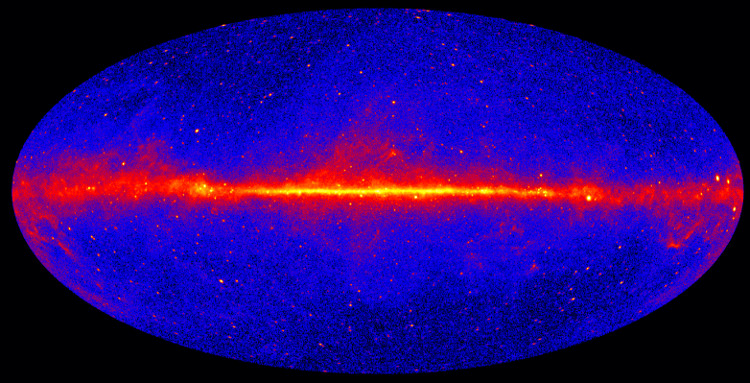What Are Gamma Rays and Gamma Bursts? What Do They Mean for Our Lives? Join us as we explore gamma rays and gamma bursts in the article below.
What Are Gamma Rays?
Gamma rays (symbol: γ) are a type of electromagnetic radiation or photons with extremely high frequencies. Gamma rays have the shortest wavelengths (E-14m ÷ E-12m) and the highest frequencies (E20 – E24 Hz) among electromagnetic waves, thus carrying much more energy than radio waves, microwaves, visible light, infrared radiation, ultraviolet rays, and X-rays.
Exploring Gamma Rays
Gamma rays were first observed in 1900 by French chemist Paul Villard while he was studying radiation emitted by radium, according to NASA documentation. A few years later, New Zealand-born chemist and physicist Ernest Rutherford proposed the name “gamma rays,” following the naming of alpha and beta rays – terms used for other particles observed from nuclear radiation – and thus the term gamma rays originated.

A full-sky image constructed from two years of observations by NASA’s Fermi Gamma-ray Space Telescope, showing what the sky looks like in gamma rays. (Image: NASA/DOE/Fermi LAT Collaboration).
Origins of Gamma Rays
On Earth, gamma rays are typically produced by gamma decay from natural radioactive isotopes and secondary radiation from interactions with particles in cosmic rays. There are also natural gamma sources that are not of nuclear origin, such as lightning.
In outer space, many processes can produce gamma rays, and simultaneously, very high-energy electrons are generated. These, in turn, cause secondary gamma rays through mechanisms such as bremsstrahlung radiation, inverse Compton scattering, and electron radiation. Most cosmic gamma rays are blocked by Earth’s atmosphere and can only be detected by space research stations or spacecraft.
Applications of Gamma Rays
Gamma rays are used in surgery and treatment of diseases related to tumors, vascular malformations, and functional brain disorders. Gamma rays help doctors accurately locate damage sites, leading to effective treatment. A surgery performed using this method in Vietnam costs only 1/6 or 1/8 of what it costs in other countries in the region.
Gamma rays are primarily applied in industrial flaw detection and healthcare. Industrial flaw detection essentially uses the penetrating power of gamma rays to check for issues within the internal structure of industrial products.
In medical treatment, gamma knives and radiation therapy are commonly used. X-rays also play a significant role in medical treatment, primarily used for imaging to assess the internal condition of the human body. The energy of gamma rays is much greater than that of X-rays, allowing them to destroy lesions through the surface of the human body, effectively targeting cancer cells and tumors without leaving trauma, thereby reducing harm to the human body and also aiding in trauma surgery.
Humans Can Now Create High-Energy Gamma Rays
Today, humans not only benefit from natural gamma rays, but scientists have also begun producing high-energy gamma rays. In September 2011, a research team from the University of Strathclyde in the UK discovered that ultra-short laser pulses could interact with ionized gases to produce a powerful laser beam.
The laser beam obtained by the research team is a trillion times brighter than the sun and can penetrate a 20 cm thick lead plate, with a 1.5-meter thick concrete wall needed to completely shield it.
The most visible light in the electromagnetic spectrum of the sun is at a wavelength of 480nm, while this wavelength is shorter by a trillion times, at 4.8 x 10 ^ -21m. The corresponding frequency of that short-wavelength electromagnetic wave is 6.25 x 10 ^ 28Hz, and this is certainly a very powerful gamma ray beam.
This innovative discovery is significant and has the potential to be used in many fields in the future, such as improved medical imaging, radiation therapy, and broader applications in scientific and industrial experiments. However, its lifespan is only 10 millionths of a second, fast enough to capture the nuclear reactions to stimuli, thus facilitating deeper research into nuclear physics.
Therefore, it can be concluded that humanity has understood and mastered the principles of gamma rays, and has long begun to use this natural law to benefit mankind.
What Are Gamma Bursts?

Gamma Bursts are the most powerful explosions in the universe, second only to the Big Bang.
Gamma bursts (abbreviated: GRB from the English term Gamma Ray Burst) are an unusual emission of gamma radiation in the sky, the origin of which remains undetermined, and there is currently no method to predict the location and timing of gamma bursts.
Gamma bursts are the most powerful explosions in the universe, second only to the Big Bang. In just one second, this burst releases a tremendous amount of energy, equivalent to the energy produced by the sun over its 10 billion-year lifespan. The reason behind gamma bursts remains unexplained…
Scientists currently know one relatively certain thing: these explosions occur in very distant regions of the universe, and gamma bursts provide us with light from the past.
Due to their intense strength, gamma bursts can travel billions of light-years. For this reason, scientists regard gamma bursts as messengers from the early universe, when the first stars were just forming.


















































